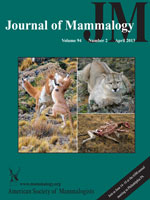The diets of large, scarce mammals are difficult to study. We compared the food habits of Asiatic black bears (Ursus thibetanus) in the Tanzawa area, Japan, from before (1989–1993) and after (2001–2010) 2000 using both fecal contents and carbon and nitrogen stable isotope ratios in bear hairs. Bears ate the same foods before and after 2000, but some food categories differed in their frequencies of occurrence in autumn. Fruits of Prunus grayama, vine fruits, colonial insects, and Sasa vegetation declined and fruits of Swida controversa and sika deer (Cervus nippon) increased significantly as parts of the fall diet after 2000. Hair samples from 18 bears collected between 1973 and 2009 indicated that bears had higher summertime δ15N rates after 2000 than before, indicating more meat in the diet. Thus, the Tanzawa bear population's diet changed over 2 decades. Habitat conditions may have changed, causing bears to adjust their food habits. We discuss some factors, such as vegetation changes caused by overabundant deer or bears eating deer carcasses, that may be partly responsible. We argue that long-term diet studies are valuable for detecting habitat changes at scales that may not be apparent solely with habitat monitoring.
How to translate text using browser tools
1 April 2013
Changes in diet of a small, isolated bear population over time
Shinsuke Koike,
Rumiko Nakashita,
Kyoko Naganawa,
Masaru Koyama,
Atsushi Tamura
ACCESS THE FULL ARTICLE

Journal of Mammalogy
Vol. 94 • No. 2
April 2013
Vol. 94 • No. 2
April 2013
Asiatic black bear
Cervus nippon
climate change
fecal analysis
food habits
forest ecosystem
Fruiting phenology




